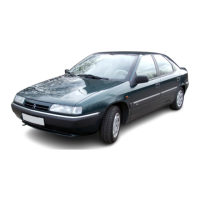Suspension 86 Suspension Explanation
128 Citroen XM Internet Reference Version 1.0
3/3/99
bar the switch is open circuit and so the ECU input rises to 5 V. This
indicates firm braking. If the brake pressure is below 35 bar, the switch
grounds the ECU input, indicating a low braking force. The SPORT switch is a
dashboard mounted switch that allows the driver to select a suspension
control program that is more suited to fast or ’sporty’ driving.
Actuators
The Hydractive actuator units are solenoid valves termed ’electro-valves’,
which are fitted to each ’third spring’ (Figure 7.25). With no power
applied, the electro-valve is held in the OFF position by a strong return
spring. This isolates the third spring and so places the suspension in the
FIRM mode (two springs per axle) with FIRM damping. To switch to the SOFT
state (three springs per axle, mild damping), the ECU energizes the
electro-valve. This is accomplished by supplying the coil with maximum
voltage (about 13.5 V) for a half-second to ’pull-in’ the plunger, and then
’chopping’ the current at 1 kHz to obtain a ’holdin’ current which averages
to about 0.5 A. To safeguard against open or short-circuited solenoid
windings the ECU uses ’smart’ transistors which continuously check for the
specified coil resistance (about 5 Q). The output current is shut off if an
incorrect resistance is detected, and the system defaults to the ’FIRM’
mode.
[Image]
Hydractive ECU
The Hydractive ECU is a sealed unit mounted in the engine compartment. It
uses two microprocessors to validate, compare and perform calculations on
data obtained from the sensors to estimate longitudinal, lateral and
vertical body accelerations. To determine the optimum suspension setting for

